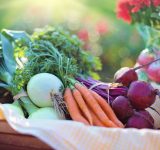February is American Heart Month. It’s a powerful opportunity to raise awareness and education regarding heart disease, which is the leading cause of death for both men and women in the United States. Factors such as diabetes, poor diet, physical inactivity, obesity and excessive alcohol use can increase odds of getting heart disease. In this article, we’ll explore three powerful botanicals and their uses in the prevention of heart disease and related illness.
Garlic
A well-known member of the Allium vegetable family (which includes onions, leeks, and chives), garlic has incredible medicinal properties.
Health benefits include:
Prevention and treatment of cardiovascular disease including atherosclerosis (inflexible arteries), hyperlipidemia (elevated fat levels in the blood) and thrombosis (blood clots).
How do you include garlic in your diet?
Chopped, minced, whole, raw or cooked, it’s all good for you! Add it to vegetable or meat dishes or roast an entire bulb for a warm, creamy treat. To make your own, check out this recipe by TheKitchn.
Turmeric
This spice has gained popularity due to its impressive health benefits, which include protection against heart failure and prevention of cardiovascular disease.
Health benefits include
The main health compound in turmeric is curcumin, which provides anti-inflammatory effects that extend beyond heart health. Curcumin increases the antioxidant capacity of the body and improves brain function.
How do you include turmeric in your diet?
Sprinkle turmeric spice on oatmeal, eggs, stir-fries, green lentil pasta or smoothies. You may want to consider turmeric supplements if you need a higher concentration. Always check with your doctor or healthcare provider before taking supplements.
Kidney Beans
High-potassium foods are helpful to maintain normal blood pressure and reduce hypertension.
Health benefits include
A one-cup serving of kidney beans contains 717 mg or 20% of your daily recommended intake of potassium. They are chock-full of protein, fiber and many minerals, including molybdenum, copper, manganese, and magnesium.
How do you include kidney beans in your diet?
Cook a big batch on a Sunday and utilize throughout the week. Add to soups, dips or eat as a simple accompanying side dish to your main meal. Before use, you may want to soak beans to reduce phytic acid, which will make them more digestible.







